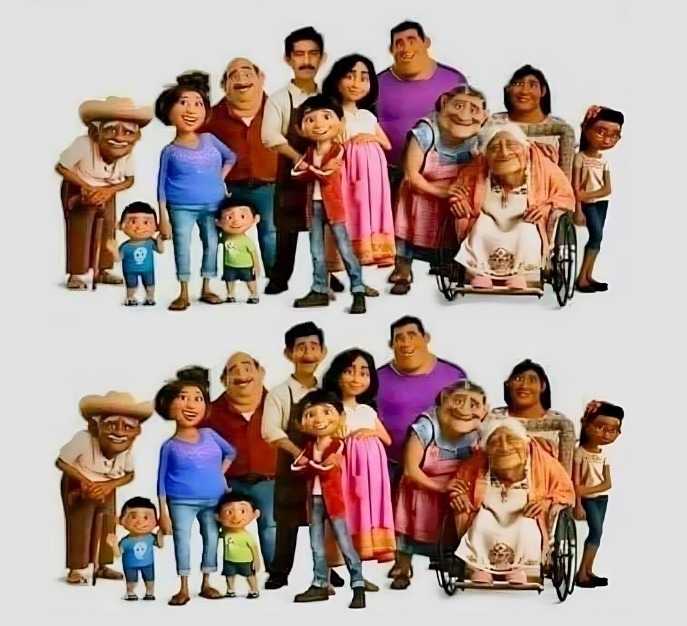Have you ever stumbled across a “spot the difference” puzzle and thought it looked too simple—only to be stumped by a seemingly impossible-to-find discrepancy? Today’s challenge will put your observation skills to the test. Look closely at these two images. At first glance, they seem identical, but there’s one subtle difference hidden in plain sight. Can you find it?
The Fascination Behind Spot-the-Difference Puzzles

Spot-the-difference puzzles aren’t just a fun way to pass the time—they’re a fantastic brain workout. These puzzles force us to pause, focus, and analyze, sharpening our attention to detail. What makes them so captivating? It’s the mix of simplicity and complexity. The premise is straightforward, but the challenge lies in the execution.
This particular puzzle ups the ante by having just one difference. For many, that minimalism makes it even trickier. You might find yourself scanning the image repeatedly, only to miss the change hiding in the details.
Why Do We Miss the Differences?
Finding the discrepancy in a “spot the difference” puzzle often proves harder than expected. Why is that? Here are some common reasons:
- Assuming Big Differences: We’re conditioned to look for obvious changes—missing objects, swapped colors, or misplaced items. When the change is subtle, like a slight shift in expression or a minor detail, it’s easy to overlook.
- Overlooking Small Details: Small alterations, like a character’s hand position or a tiny facial change, blend seamlessly into the image, tricking the eye.
- Focusing on the Wrong Areas: Sometimes, our eyes gravitate toward certain parts of an image while ignoring others. This bias can prevent us from spotting the difference, even if it’s right in front of us.
- Pattern Recognition Bias: Our brains naturally seek symmetry and patterns. Subtle changes often go unnoticed because our minds “fill in the blanks” and assume the images are identical.
Step-by-Step Guide to Solving This Puzzle
If you’re struggling to find the difference, don’t worry. Let’s break down how to tackle this puzzle systematically:
Step 1: Take a Holistic View
Start by observing the images as a whole. Compare them side by side without focusing on specific details yet. Sometimes, a quick scan can reveal glaring inconsistencies.
Step 2: Divide the Image into Sections
Mentally split the images into zones—top, middle, and bottom. Compare these sections one at a time. This focused approach makes it easier to catch subtle differences that might otherwise escape notice.
Step 3: Pay Attention to Characters
In this puzzle, the key difference lies in the group of characters. Analyze each character’s face, posture, and expression carefully. Pay extra attention to their eyes, noses, and hands—small changes in these areas are common in such puzzles.
Step 4: Focus on the Man Next to the Pregnant Woman

After systematically scanning the image, the difference becomes clear. Look closely at the man standing next to the pregnant woman. His expression and features differ slightly between the two images. Specifically, focus on his eyes, nose, and overall facial expression. This subtle yet distinct change is the answer to the puzzle.
Why Small Differences Are So Difficult to Spot
Even when the answer is pointed out, many people are amazed they didn’t notice it earlier. Why does this happen?
- Cognitive Bias: Our brains tend to assume two images that look similar are identical, especially when scanning quickly.
- Inattentional Blindness: When we focus intensely on one part of an image, we often fail to notice changes elsewhere. This phenomenon, called inattentional blindness, is a common stumbling block in puzzles.
- Information Overload: With so many details to process, the brain can easily miss minor inconsistencies, especially in complex images with multiple elements.
Benefits of Solving Spot-the-Difference Puzzles
These puzzles aren’t just a source of entertainment—they’re also great for mental fitness. Here’s why they’re worth your time:
- Improves Attention to Detail: Regular practice trains your brain to notice subtle differences, which can enhance observational skills in daily life.
- Boosts Memory: Comparing and contrasting elements in two images strengthens memory by forcing the brain to retain and recall information.
- Encourages Patience and Focus: These puzzles require careful examination, teaching you to slow down and approach problems methodically.
- Enhances Problem-Solving Skills: By analyzing discrepancies, you engage your logical thinking abilities, a skill useful in countless real-life situations.
Challenge Your Friends!
Now that you’ve cracked the puzzle, why not challenge your friends or family? Share the image and see how quickly they can spot the difference. You might be surprised at how varied the responses are—some will solve it instantly, while others may struggle.
Encourage them to share their thought process. Did they start by scanning the image as a whole, or did they dive into specific sections? How long did it take them to find the answer? Comparing strategies is half the fun.
Final Thoughts
Spot-the-difference puzzles like this one are a delightful way to test and improve your observation skills. They remind us of the importance of paying attention to the little things—whether in a puzzle or in life. By practicing patience and sharpening your focus, you’ll not only become a master at solving these challenges but also develop skills that translate to everyday tasks.
So, what are you waiting for? Dive into another puzzle, challenge your brain, and don’t forget to enjoy the journey. After all, life’s most satisfying moments often lie in the smallest details. Happy puzzling!
